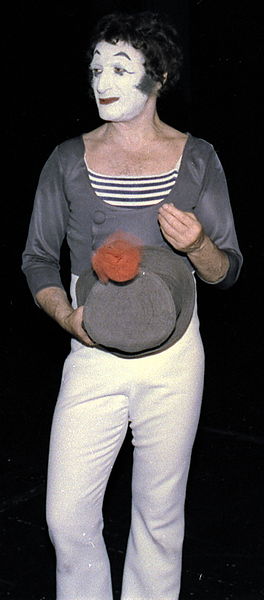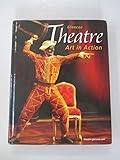Marcel Marceau - a remarkable mime artist

What is a mime artist?
As a child our family lived in southern New Jersey just less than two hours from New York City and I was fortuate to be able to see and experience the theatre in New York. One of my favorite memories is of seeing a performance of Marcel Marceau, the great mimic and mime artist. As a child I was enthralled with watching him perform. And, later, at home, my friends and I would try to mimic the greatest mimic and mime artist of all time. But what exactly is a mime artist?
A mime artist is someone who uses mime as a theatrical performance to act out a story through body motions without the use of speech. In earlier times, in English, these performers were also called mummers. The performance of pantomime actually originates way back in ancient Greece. The name is taken from a single masked dancer called a pantomimus, although at that time not all performances were necessarily silent. Later, in medieval Europe, early forms of mime such as mummer plays evolved that were totally silent. And, by the 19th century in Paris, France, Jean-Gaspard Deburau introduced the silent mime in white face that Marcel Marceau made so famous.
By the 20th century a new medium brought the mime artist to us and that was through the motion picture. Silent film comedians such as Charlie Chaplin, Harold Lloyd, and Buster Keaton delighted audiences, first by learning the craft in the theatre, and then through film they had a great influence on the art. They created a vast audience for mime and made it popular to the masses.
Traditionally, mime performances involved the actor wearing tight black and white clothing with white facial make-up. Today, contemporary mimes often perform without whiteface and are very popular as street mime artists, especially in the large European cities. In Barcelona, Spain, take a stroll down La Rambla and you will see mime artists in action and standing stoic as live mannequins. Many a time I have accompanied my Spanish students down La Rambla as a mime artists ate imaginary bugs from my head and hair, much to the delight of my students and passerbys. I have always enjoyed mime wherever I have found it, but the master of them all was Marcel Marceau, a remarkable mime artist.
Marcel Marceau 1923-2007
Marcel Marceau was born Marcel Mangel and into a Jewish family in Strasbourg, France. He had a remarkable life as well as becoming a renowned mime artist in his adult years. He had a typical childhood and education in Strasbourg. His father was a kosher meat butcher and all was well until World War II loomed ahead. With the beginning of the war, his family fled to Limoges, France. Marcel and his brother managed to stay hidden away in Limoges, but his father and mother were picked up and deported to Auschwitz concentration camp. His father was killed at the camp, but his mother managed to survive Auschwitz, a feat in itself.
It was at this time, that Marcel and his brother adopted the last name Marceau during the German occupation of France. The name was chosen in reference and respect to Francois Severin Marceau-Desgraviers, a general in the French Revolution.
The two brothers joined the French Resistance in Limoges and saved many Jewish children from race laws and concentration camps. Marcel actually started miming as a way of keeping the children quiet as they were escaping to Switzerland. He was so good at it that at the end of WWII he enrolled as a student in Charles Dullin's School of Dramatci Art in the Sarah Bernhardt Theatre in Paris. Here he studied with the great pantomime master at the time, Etienne Decroux.
After studying, he joined Jean-Louis Barrault's theatre company and was cast in the role of Arlequin in the famous pantomime, "Baptiste." This role won him so much acclaitm that he was encouraged by theatre professionals to present his first "mimodrama," "Praxitele and the Golden Fish" at the Bernhardt theatre that same year. He was so well acclaimed in that role that Marceau's career as a mime was firmly establised.
He created his loveable alter-ego, Bip, the Clown in 1947 and played at the Pocket Theatre in Paris. He wore a striped pullover and a battered beflowered silk opera hat. Marceau always said that the costume symbolized life's fragility and just as the "Little Tramp" became Charlie Chaplin's alter-ego, Bip became Marceau's.
Bip's misadventures were performed with everything fron butterflies to lions, from dance-halls to restaurants, and from ships to trains. His silent mimed exercices all became classic displays and as a style of pantomime, Marceau was without peer. HIs satires on everything from sculptors to matadors were described as works of genius,
In 1949, after winning several prestigious performance awards, Marceau founded and opened the Compagnie de Mime Marcel Marceau. At the time, this was the only company of pantomime in the world. His ensembles were so highly regarded that they played only the great theatre houses of the world. They performed all over the world to spread the "art of silence." He finally toured the U.S. in 1955 and 1956 to SRO crowds in San Francisco, Chicago, Washington, DC, Philadelphia, Los Angeles, and New York. His last U.S. tour was in 2004; his last European tour was in 2005; and his last Australian tour was in 2006.
Besides mime, he also was an author of children's poetry books. And, an amazing fact, he received an honorary doctorate from Ohio State University right here in the state of Ohio.
Marcel Marceau spoke volumes to the world without ever uttering a sound.. His mime theatre always had a moral to the lessons he taught us through his amazing body and motions. I would watch spellbound, as well as the rest of the audience, as he acted out his vignettes for us. Not a word spoken, yet we learned so much about life from him. He was the epitome of the phrase: "Silence is Golden."
Copyright (c) 2012 Suzannah Wolf Walker all rights reserved










